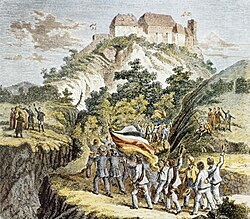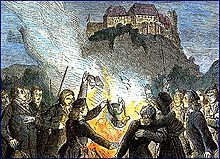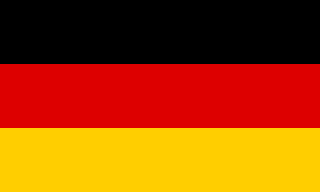
The national flag of Germany is a tricolour consisting of three equal horizontal bands displaying the national colours of Germany: black, red, and gold. The flag was first sighted in 1848 in the German Confederation. The flag was also used by the German Empire from 1848 to 1849. It was officially adopted as the national flag of the German Reich from 1919 to 1933, and has been in use since its reintroduction in Federal Republic of Germany in 1949.

The Wartburg is a castle originally built in the Middle Ages. It is situated on a precipice of 410 metres (1,350 ft) to the southwest of and overlooking the town of Eisenach, in the state of Thuringia, Germany. It was the home of St. Elisabeth of Hungary, the place where Martin Luther translated the New Testament of the Bible into German, the site of the Wartburg festival of 1817 and the supposed setting for the possibly legendary Sängerkrieg. It was an important inspiration for Ludwig II when he decided to build Neuschwanstein Castle.

August Friedrich Ferdinand von Kotzebue was a German playwright, who had also worked as a Russian diplomat.

A Burschenschaft is one of the traditional Studentenverbindungen of Germany, Austria, and Chile . Burschenschaften were founded in the 19th century as associations of university students inspired by liberal and nationalistic ideas. They were significantly involved in the March Revolution and the unification of Germany. After the formation of the German Empire in 1871, they faced a crisis, as their main political objective had been realized. So-called Reformburschenschaften were established, but these were dissolved by the Nazi regime in 1935/6. In West Germany, the Burschenschaften were re-established in the 1950s, but they faced a renewed crisis in the 1960s and 1970s, as the mainstream political outlook of the German student movement of that period started leaning more towards the left. Roughly 160 Burschenschaften exist today in Germany, Austria and Chile.
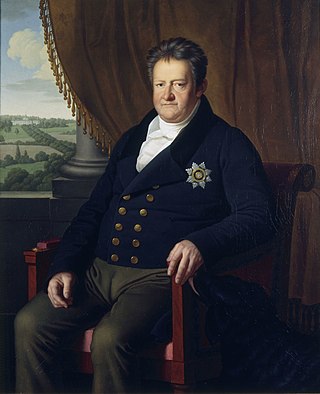
Karl August, sometimes anglicised as Charles Augustus, was the sovereign Duke of Saxe-Weimar and of Saxe-Eisenach from 1758, Duke of Saxe-Weimar-Eisenach from its creation in 1809, and grand duke from 1815 until his death. He is noted for the intellectual brilliance of his court.

Karl Ludwig Sand was a German university student and member of a liberal Burschenschaft. He was executed in 1820 for the murder of the conservative dramatist August von Kotzebue the previous year in Mannheim. As a result of his execution, Sand became a martyr in the eyes of many German nationalists seeking the creation of a united German national state.
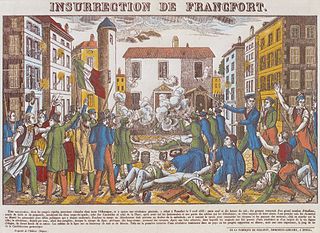
The Frankfurter Wachensturm on 3 April 1833 was a failed attempt to start a revolution in Germany.

Freyburg is a town in the Burgenlandkreis district, in Saxony-Anhalt, Germany. It is situated on the river Unstrut, 9 km northwest of Hanseatic Naumburg, 63 km from Leipzig and 231 km from Berlin. It is part of the Verwaltungsgemeinschaft Unstruttal. On 1 July 2009 it absorbed the former municipalities Pödelist, Schleberoda, Weischütz and Zeuchfeld. Freyburg consists of the Ortsteile (divisions) Dobichau, Freyburg, Nißmitz, Pödelist, Schleberoda, Weischütz, Zeuchfeld and Zscheiplitz.

Heinrich Luden was a German historian.

Eduard Heyck was a German cultural historian, editor, writer and poet.

Freiherr Karl Albert Christoph Heinrich von Kamptz was a German jurist and Prussian Ministers of Justice from 1832 to 1842.
Saul Ascher was a German writer, translator and bookseller.

Karl Friedrich Heinrich Marx was a German physician and college lecturer. Despite sharing the same name, he was not related to Karl Marx, the founder of Marxism.

Eisenach Charterhouse is a former charterhouse, or Carthusian monastery, in Eisenach in Thüringia, Germany, founded in 1378 and suppressed in 1525.
Christian Theodor Ludwig Lucas, also known as Ludwig Lucas or C. T. L. Lucas, was a German writer and pedagogue.

Karl Friedrich Wilhelm Rußwurm was a German-Estonian pedagogue, ethnologist and historian.

Friedrich Johannes Frommann was a German publisher, bookseller and politician.

Friedrich Gustav von der Leyen was a German philologist who specialized in Germanic studies.

Ludewig Gottlieb Carl Nauwerck was a German journalist, orientalist and member of the Frankfurt Parliament.
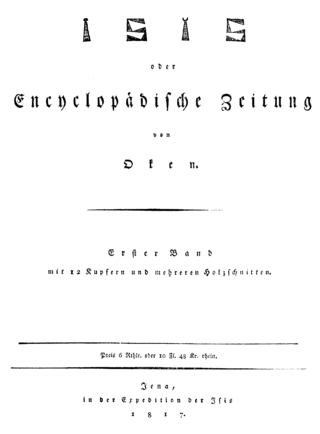
Isis was an encyclopedic journal that focused on articles on natural science, medicine, technology, economics as well as art and history. It also published important articles on science policy and the organization of science. Edited by Lorenz Oken and published by Friedrich Arnold Brockhaus, Isis was the first interdisciplinary journal in the German-speaking world.
